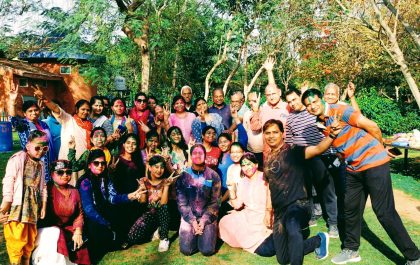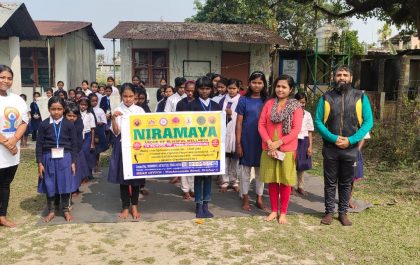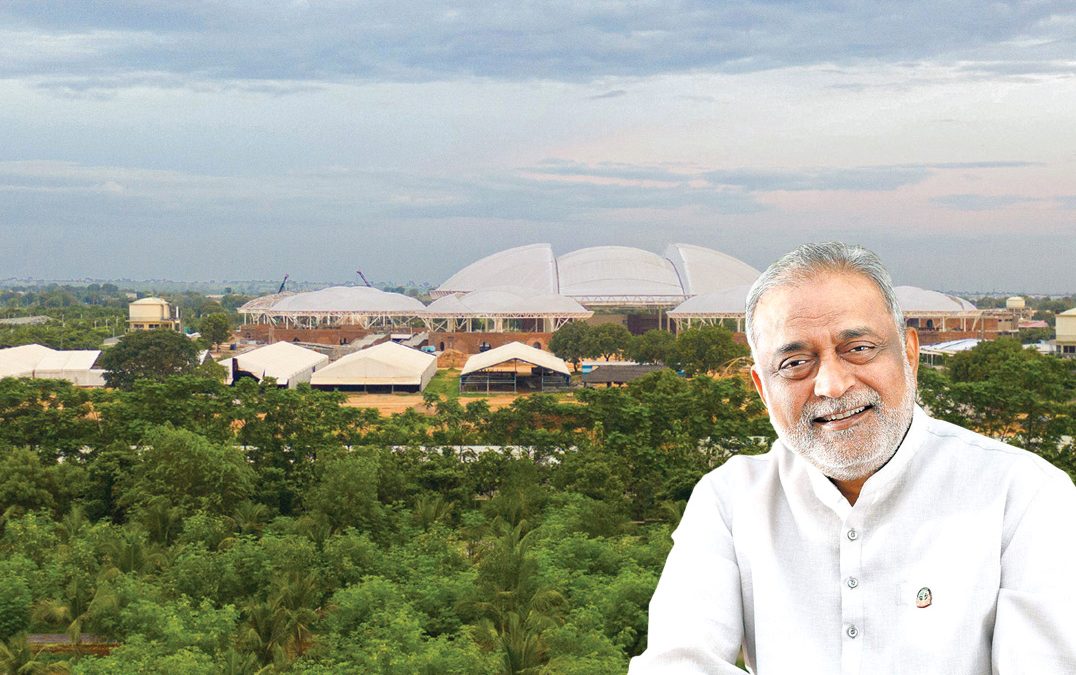Ghantali Mitra Mandal (GMM), Member Institute of Indian Yoga Association has entered the Diamond Jubilee Year of its foundation. All at GMM are giving relentless and selfless service to society to make Yoga maximum applicable. On the eve of new year, a grand function of…
Heartfulness is a century-old spiritual tradition originating in India, previously known as the Sahaj Marg system of Raja Yoga offered by the Shri Ram Chandra Mission, which was founded in 1945. The four Masters in this spiritual tradition have offered their services tirelessly to humanity for spiritual upliftment and overall wellbeing. They have all been family men, including the current Heartfulness Guide, Daaji, who is also the President of Shri Ram Chandra Mission. They have worked in various professions and raised families, in parallel with attaining great spiritual heights. This is reflected in their research on Yoga and spirituality, their practical support to seekers from across the globe, and their teachings offered freely in their lifetimes and bequeathed to all humanity. It all began in the last quarter of the 19th century, when Shri Ram Chandra, a saint from the small town of Fatehgarh in the State of Uttar Pradesh in India, rediscovered the ancient yogic practice of Transmission, or pranahuti, which was originally used 72 generations before King Dasharatha, the father of Lord Rama, as a means of spiritual training. Born in 1873 into the family of a landlord and raised in an environment of comfort, Ram Chandra lost all the wealth inherited from his father in a litigation while he was still a young man bringing up a family of his own. While accepting poverty, he managed to get a job in the local courts as a clerk and provide for his family. Amidst the dramatic events of his life, his search for Truth, which he carried in his heart since childhood, eventually led him to a state in which he received the experience and knowledge of pranahuti at a fairly young age.
According to his own testimony, he achieved God-Realization as a result of his ardent craving, devotion and submission to the divine will. His rediscovery of pranahuti was the beginning of a Divine Revolution and he set about creating a system of spiritual training that could bring about an inner transformation in any willing seeker, enabling them to have a direct experience of the Divinity within. He also set the guiding principle that there would be no fees charged for the spiritual training imparted through the use of pranahuti. Ram Chandra came to be known as Lalaji by his associates, and he not only provided his services for the spiritual upliftment of willing seekers but also enabled some of his associates to transmit pranahuti to others. He was continuously engaged in research on spiritual subjects and was a prolific writer. Some of his writings are available in a series of books published by the Heartfulness Institute – Truth Eternal, Complete Works of Ram Chandra, Vol. 2, Complete Works of Ram Chandra, Vol. 3, Complete Works of Ram Chandra, Vol. 4, and a fifth volume is currently being compiled from his letters to his associates and followers.
The Founder
On 3 June 1922, Lalaji was approached by a youth from Shahjahanpur, a town close to Fatehgarh. The youth bore the same name as his, Ram Chandra. Born in 1899 he was from a well-to-do family and was searching for a capable guide from a very young age. He instantly accepted Lalaji as his spiritual guide, and a unique relationship of Master and disciple ensued between the two, which resulted in the 22-year-long training period of Ram Chandra of Shahjahanpur under Lalaji. In 1945, under the instructions of Lalaji from beyond this world through a very special communication, Ram Chandra of Shahjahanpur revealed himself as the spiritual successor of Lalaji and also founded Shri Ram Chandra Mission in the memory of his Master. Ram Chandra of Shahjahanpur came to be fondly known as Babuji. Both Lalaji and Babuji can aptly be described as a spiritual scientist, carrying forward research in the tradition of Maharishi Patanjali. Their research has completely revolutionized the field of Yoga for the modern era. The ultimate purpose of Yoga is union of the individual soul with its Source, and this process is often represented poetically as the merger of the water drop in the Ocean. Patanjali identified eight aspects or steps in Yoga, all leading to that state of union with the Source known as Samadhi – the original state of balance that existed before creation. Patanjali’s model of spiritual training came to be known as Ashtanga Yoga, meaning the eight-step path, starting with Yama and culminating in Samadhi. Babuji considered the state of Samadhi as a launching point for the experience of further evolved states of consciousness, and going beyond consciousness to arrive at what he termed the Ultimate or the Absolute. It is only here that the journey of TRADITIONAL CHAKRAS
a seeker results in a state of oneness. The seeker is one with the Goal. In his writings, Babuji explains the journey of human consciousness back to the Source, which he defined as “the real goal of human life.” These explanations define the journey in terms of the chakras of the human system, the various koshas or coverings around the soul, and also the regions of the human system associated with the body, mind and soul – the Heart Region, Mind Region and Central Region. He also introduced a revision of the human chakra system based on his original research. Babuji’s research revealed 13 chakras in the human spiritual anatomy, in addition LOCATION OF THE CHAKRAS FROM THE HEART TO THE CENTRAL REGION to the three lower chakras. Prior to his findings, for thousands of years, yogis have acknowledged 7 chakras – muladdhara, swadhisthana, manipura or nabhi, anahata, vishuddha, ajna, and sahasrara dal kamal. Babuji described this newer understanding of our spiritual anatomy in a very detailed and scientific way in his book, Towards Infinity.
Besides these chakras, which Babuji also referred to variously as knots or granthis, centres, or points, there exist many sub-points with different functions. He also presented in a systematic way the description of the various spiritual states at each of these chakras, some of which are well known in the yogic and Sufi traditions, and others which were his own discoveries. He beautifully described the spiritual yatra, the journey of sequentially awakening the chakras all the way to the Source, and gave birth to the system of practices designed to facilitate this yatra, which he called Sahaj Marg, meaning ‘the natural path’. His original research is contained in a series of books entitled Reality at Dawn, Efficacy of Raja Yoga in the Light of Sahaj Marg, Commentary on the Ten Maxims of Sahaj Marg, Towards Infinity, Sahaj Marg Philosophy, which comprise his Complete Works volume 1, as well as his Complete Works volumes 2, 3, 4, 5 and 6.
Sahaj Marg incorporates all the elements of traditional yogic systems in a natural way to suit a modern lifestyle. In essence, Sahaj Marg is what Yoga was always intended to be – a way of life rather than a set of practices.
Babuji defined pranahuti or Transmission as “the utilization of divine energy for the transformation of human beings.” This transformation is essentially the process of the progressive refinement of consciousness, which results in balance and harmony in the human physical and psychic systems, correcting the vrittis or disturbances in the energy field. He introduced the understanding that the eight steps of Patanjali’s Ashtanga Yoga are not necessarily a linear progression, but can be done simultaneously. This is because pranahuti brings about the state of Samadhi, which in turn makes it easier for a seeker to realize the other steps more easily in the course of the journey. These steps also represent the states of purification and refinement required to retain the state of Samadhi.
Shri Ram Chandra Mission was established by Babuji in 1945 with the objective of taking Yoga to every household, and to make this possible he continued with Lalaji’s tradition of enabling his associates to impart training with Transmission. He travelled widely in India and later to parts of Europe, North America, Southeast Asia, and South Africa, to offer these practices to willing seekers. He also set up ashrams with residential facilities to help practitioners intensify their practice. Evolutionary guides, the system and organization After Babuji’s mahasamadhi on 19 April 1983, the work was carried forward by his disciple Shri Parthasarathi Rajgopalachari, popularly known as Chariji. Born in 1927, Chariji was educated in the Western tradition and had a successful career in the corporate sector, while pursuing Sahaj Marg as a close disciple of Babuji. He met Babuji in 1964 and he was granted permission to work as a trainer in 1967, soon after becoming the General Secretary of Shri Ram Chandra Mission. Babuji often remarked that an ideal combination for a human being is a Western mind and an Eastern heart. Chariji was a perfect example of such a being.
With his vision and administrative acumen, Chariji expanded the Mission worldwide, truly transforming it into a global entity. He set up ashrams, which he called Centres of Light, across the length and breadth of India and in many countries abroad. Training and Research Centres were also set up under his watch. Both the number of practitioners and trainers grew rapidly and outreach programs for schools followed. Chariji was a prolific reader and writer, and a charismatic, dynamic and eloquent speaker. His main topic was Babuji, and he spoke incessantly about his philosophy, his life and his work. He always said that his own thoughts were an expansion in simpler terms of the core teachings of his Master, Babuji. He travelled almost continuously meeting seekers across the globe until finally his health permitted it no more. He added a great volume of literature by way of his spiritual diaries, his autobiography, his iconic book, My Master, and a huge collection of talks delivered over a period of almost fifty years. He also set up sister organizations like the Sahaj Marg Spirituality Foundation and two publication trusts to undertake specific initiatives. He handed over the mantle in his lifetime to Shri Kamlesh Patel, his long-time associate and confidante, and attained mahasamadhi on 20 December 2014.
Shri Kamlesh Patel is known to many as Daaji. Daaji was born in Gujarat in 1956, and acquired his education and professional qualification in Pharmacology before migrating to the USA, where he raised a family and set up a successful pharmacy business, which continues to thrive. Like Chariji, he too exemplifies the coming together of the Western mind and the Eastern heart, in tune with the foremost principle of Sahaj Marg that the spiritual and material aspects of human life must both be developed, like the two wings of a bird. He has expedited the growth of the Mission in all areas. And so that the simple practices are more easily accessible to all, he has called the approach Heartfulness, offering the promise of advancing in the way of love.
Daaji has written two international bestsellers – The Heartfulness Way, followed closely by Designing Destiny, and regularly writes articles and series in Heartfulness Magazine and many (www.heartfulnessmagazine.com) other publications worldwide. More of his articles can be read at www.daaji.org. He is also a prolific speaker, and his talks can be viewed on the Heartfulness YouTube channel. He has set up the Heartfulness Institute and the Heartfulness Education Trust to take forward the initiatives aimed at reaching out to different groups in society. In a very short time he has expanded the network to include over 5,000 Heartfulness centres, and 14,000 certified trainers voluntarily serving around four million practitioners in 140 countries.
There are four core Heartfulness practices for beginners (www.heartfulness.org): Relaxation, heart-based Meditation with Transmission, Cleaning of mental complexities and impurities and Prayer for connecting with the Source. Trainers provide newcomers with introductory meditation sessions, after which they then support them in their practice and regularly offer practical sessions with Transmission. These ongoing sessions can be done face to face or remotely as is largely the case in the present situation of the pandemic.
Daaji and the Heartfulness volunteers worldwide continue to reach out to all of humanity, in order to offer this wonderful set of simple daily practices and lifestyle guidelines for physical, mental, emotional and spiritual well-being
The Legacy Series articles are contributed by institutional members of IYA and are published as provided by them; we encourage all Member Institutions of the Association to send a six page article with some photos about their organisations
















